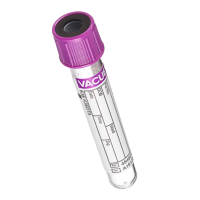
Test Code: 97713
CPT Code: 87799
Alternative Name(s): EBV DNA QN PCR
Methodology: Polymerase Chain Reaction
Clinical Significance: Epstein-Barr virus (EBV), also known as Human Herpesvirus 4, is a ubiquitous double-stranded DNA virus that belongs to the human herpesvirus family. EBV is one of the most common human-associated viruses in existence; approximately 95% of the world’s adult population has been infected with EBV and remain lifelong carriers.1,2 Primary infection is generally asymptomatic in childhood but can lead to infectious mononucleosis in adolescents and young adults. Following primary infection, the virus establishes lifelong persistence in B cells.
Other EBV-related infections are: chronic active EBV infection as well as lymphoproliferative EBV-infections. Post-transplant lymphoproliferative disease (PTLD), which is EBV-associated in 90% of the cases, is a serious illness which can occur in immunosuppressed transplant recipients.4 There are 2 EBV subtypes, type 1 being dominant in the Western hemisphere and Southeast Asia and type 1 and 2 being equally prevalent in Africa.5 In immunocompromised patients, rising EBV viral titers should raise the suspicion for EBV-related PTLD; however, diagnosis must be confirmed by biopsy.
Quantitative assessment of EBV viral load is one of the most effective methods for supporting clinical management, as it can accurately distinguish healthy low-level carriers from high-level infected patients.8 Even before a disease manifests, high-risk individuals, such as transplant patients, can benefit from regular screening tests to track possible disease progression.8,9 Traditional serological methods for EBV detection are discouraged in immunosuppressed individuals due to the high probability of varied serology profiles and, consequently, real-time PCR is becoming widely accepted as the principal technology for viral load measurement.
Treatment for EBV-related illness varies based on immunocompetence as well as type of EBV-related illness. For EBV-associated PTLD in transplant patients, therapeutic strategies include a reduction in immunosuppression for 2-4 weeks, Rituximab (monoclonal Ab) monotherapy, chemotherapy, EBV-specific cytotoxic T-cell therapy and steroids. The use of antiviral drugs is not recommended due to data showing lack of efficacy.
The Alinity m EBV amplification reagents include primers and probes that amplify and detect dual targets in the EBV genome. Amplification and detection of the two EBV targets ensures sensitive detection of the viral genome even at low levels. In addition to the EBV primers and probes, the assay utilizes an internal control (IC) primer/probe set for amplification and detection of the IC target sequence, which is not related to EBV. The IC probe is labeled with a different fluorophore than the EBV probes. This allows for simultaneous detection and discrimination of both the EBV and IC amplified products within the same reaction vessel.
Supply: #T59 - Lavender 4mL Blood Tube
Preferred Specimen: Plasma
Preferred Volume: 2mL
Collection Instructions: Mix by gentle inversion 3-4 times. Centrifuge to separate plasma from cells. Remove plasma immediately and refrigerate.
Transport Container: Pour off tube
Transport Temperature: Refrigerated
Specimen Stability: Refrigerated: 5 days
Reject Criteria:
Specimens exceeding stability, specimens collected in collection devices/tubes other than EDTA
For additional test, supply, or collection device information, please contact DLO's Customer Service at (800) 891-2917, option 2.
The CPT codes provided are based on AMA guidelines and are for informational purposes only. CPT coding is the sole responsibility of the billing party. Please direct any questions regarding coding to the payor being billed.
